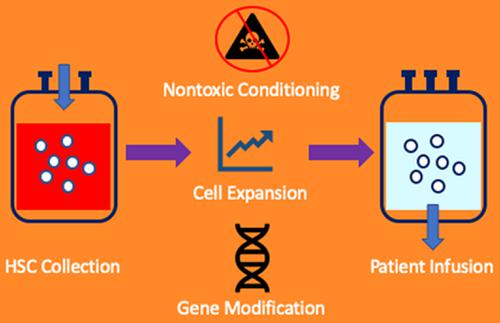当前位置:
X-MOL 学术
›
Stem Cells Transl. Med.
›
论文详情
Our official English website, www.x-mol.net, welcomes your feedback! (Note: you will need to create a separate account there.)
Unleashing the cure: Overcoming persistent obstacles in the translation and expanded use of hematopoietic stem cell-based therapies.
STEM CELLS Translational Medicine ( IF 6 ) Pub Date : 2020-01-19 , DOI: 10.1002/sctm.19-0375 Sohel Talib 1 , Kelly A Shepard 1
STEM CELLS Translational Medicine ( IF 6 ) Pub Date : 2020-01-19 , DOI: 10.1002/sctm.19-0375 Sohel Talib 1 , Kelly A Shepard 1
Affiliation

|
Hematopoietic stem cell transplantation (HSCT) is broadly used for treating and curing hematological cancers and various disorders of the blood and immune system. However, its true therapeutic potential remains vastly constrained by significant scientific and technical hurdles that preclude expansion to new indications and limit the number of patients who could benefit from, gain access to, or financially afford the procedure. To define and overcome these challenges, the California Institute for Regenerative Medicine (CIRM) held multiple workshops related to HSCT and has subsequently invested in a new generation of approaches to address the most compelling needs of the field, including new sources of healthy and immunologically compatible hematopoietic stem cells for transplant; safe and efficient genome modification technologies for correction of inherited genetic defects and other forms of gene therapy; safer and more tractable transplantation procedures such as nongenotoxic conditioning regimens, methods to accelerate immune reconstitution and recovery of immune function, and innovations to minimize the risk of immune rejection; and other life‐threatening complications from transplant. This Perspective serves to highlight these needs through examples from the recent CIRM‐funded and other notable investigations, presents rationale for comprehensive, systematic, and focused strategies to unleash the full potential of HSCT, thereby enabling cures for a greatly expanded number of disorders and making HSCT feasible, accessible, and affordable to all who could benefit.
中文翻译:

释放治疗方法:克服翻译和扩大使用造血干细胞疗法的持续障碍。
造血干细胞移植(HSCT)被广泛用于治疗和治愈血液系统癌症以及各种血液和免疫系统疾病。但是,其真正的治疗潜力仍然受到重大科学和技术障碍的极大限制,这些障碍无法扩展至新的适应症,并限制了可以从中受益,获得治疗或在经济上负担得起的患者数量。为了定义和克服这些挑战,加州再生医学研究所(CIRM)举办了多次与HSCT相关的研讨会,随后投资了新一代方法来满足该领域最迫切的需求,包括健康和免疫相容性的新来源用于移植的造血干细胞;安全有效的基因组修饰技术,可纠正遗传性遗传缺陷和其他形式的基因治疗;更安全,更容易处理的移植程序,例如非遗传毒性调理方案,加速免疫重建和免疫功能恢复的方法,以及旨在最大程度降低免疫排斥风险的创新技术;以及移植带来的其他威胁生命的并发症。该观点通过最近的CIRM资助的和其他著名的研究中的例子强调了这些需求,提出了全面,系统和重点突出的策略的原理,以释放HSCT的全部潜力,从而能够治愈大量疾病并进行治疗。 HSCT对于所有受益者来说都是可行,容易获得且负担得起的。
更新日期:2020-01-19
中文翻译:

释放治疗方法:克服翻译和扩大使用造血干细胞疗法的持续障碍。
造血干细胞移植(HSCT)被广泛用于治疗和治愈血液系统癌症以及各种血液和免疫系统疾病。但是,其真正的治疗潜力仍然受到重大科学和技术障碍的极大限制,这些障碍无法扩展至新的适应症,并限制了可以从中受益,获得治疗或在经济上负担得起的患者数量。为了定义和克服这些挑战,加州再生医学研究所(CIRM)举办了多次与HSCT相关的研讨会,随后投资了新一代方法来满足该领域最迫切的需求,包括健康和免疫相容性的新来源用于移植的造血干细胞;安全有效的基因组修饰技术,可纠正遗传性遗传缺陷和其他形式的基因治疗;更安全,更容易处理的移植程序,例如非遗传毒性调理方案,加速免疫重建和免疫功能恢复的方法,以及旨在最大程度降低免疫排斥风险的创新技术;以及移植带来的其他威胁生命的并发症。该观点通过最近的CIRM资助的和其他著名的研究中的例子强调了这些需求,提出了全面,系统和重点突出的策略的原理,以释放HSCT的全部潜力,从而能够治愈大量疾病并进行治疗。 HSCT对于所有受益者来说都是可行,容易获得且负担得起的。



























 京公网安备 11010802027423号
京公网安备 11010802027423号